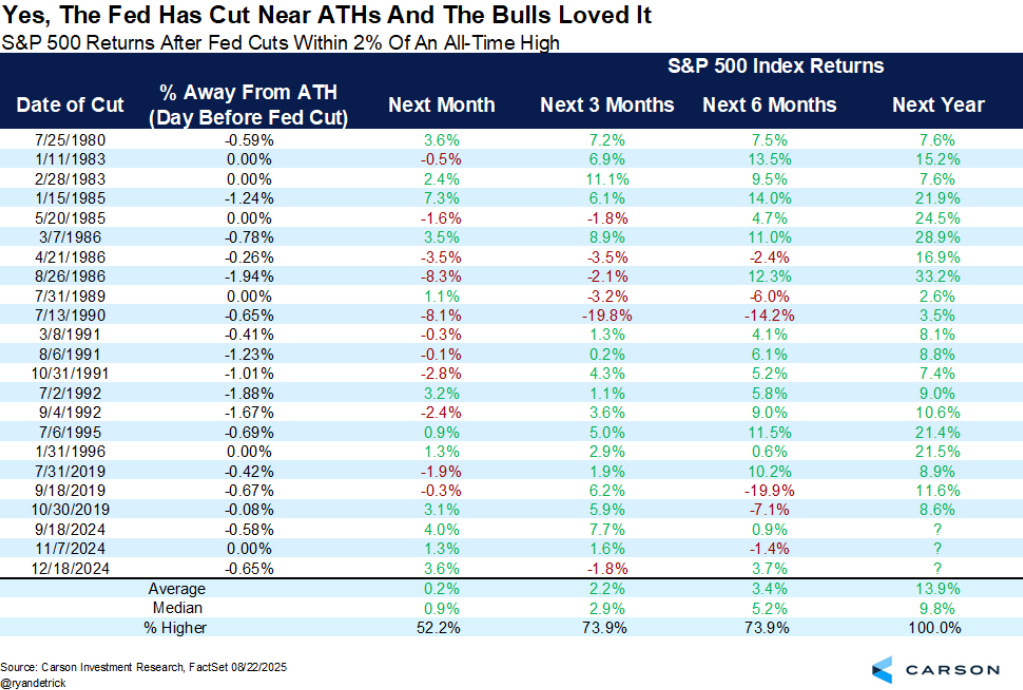Markets Panicked After the Fed Rate Cut. Smart Investors Shouldn’t.
The U.S. Federal Reserve just did exactly what Wall Street expected in the short term: cut rates by 25 basis points and projected two more cuts by year’s end.
At first glance, a rate cut should have fueled a rally – but the Fed’s forward guidance flipped the mood
Markets had been pricing in two or three cuts in 2026 – but the central bank only penciled in one. It also revised 2026 GDP expectations higher, called for steady unemployment levels, and nudged inflation estimates upward.
In other words, the Fed is saying that the economy remains strong, and inflation isn’t fully vanquished – and, therefore, it won’t commit to an aggressive cutting cycle just yet. Powell reinforced this message in the post-meeting press conference, calling this a “risk-management cut”: a signal that the Fed isn’t racing into an easing cycle but keeping optionality open.
That spooked traders into thinking this isn’t the start of a sustained easing campaign. And stocks, which had rallied hard into the meeting, promptly sold off in classic buy-the-rumor, sell-the-news fashion.
But here’s the thing: none of what Powell said is bearish.
The market’s initial tantrum was just that – a tantrum. And for disciplined investors, it’s all the more reason to buy… especially considering the current market setup.
The Fed’s Risk-Management Cut: A Pivot Without a Promise
The Fed didn’t slam the door shut on more cuts. It simply refused to pre-commit.
That’s central banking done right: going one meeting at a time, driven by data, not promises.
And guess what? The data is trending in a direction that supports further easing. Inflation is steady – not exploding. Labor markets are softening around the edges. And growth, while solid, is not running away.
Altogether, the case for further cuts remains intact. That’s why we continue to believe the Federal Reserve will cut four to five times over the next 12 months.
That’s plenty of juice to sustain a strong stock market rally into 2026. And if you’re hoping to ride that wave higher, nowhere is the buying opportunity more compelling than in AI.
Think about the dynamic: lower rates over the next year mean cheaper capital, higher valuations, and a stronger tailwind for growth-oriented sectors. AI sits at the epicenter of growth in today’s market. When liquidity improves, AI is the first place investors rush back into.
If you want to be positioned where easing cycles meet explosive innovation, AI is where you plant your flag.
AI Momentum Meets Cheaper Capital
Right now, the current fundamental AI news flow couldn’t be more bullish. Consider:
- Nvidia (NVDA) is paying $6 billion to CoreWeave for excess cloud compute. This is the world’s most valuable chipmaker, effectively saying that demand for AI compute is so insatiable that it’ll pay billions just to lock down access.
- Microsoft (MSFT) is spending $6 billion with Nuscale in Norway to secure AI infrastructure – proof that hyperscalers are scouring the globe to lock down scarce compute.
- The U.S. House of Representatives announced that it will begin rolling out Microsoft Copilot into daily workflows. This is a historic moment. If Congress – one of the slowest-moving institutions in America – is adopting AI assistants, then corporate America and Main Street won’t be far behind. Adoption curves are accelerating. That translates into stronger demand for AI software, more workloads hitting hyperscale datacenters, and more revenue for the entire AI stack.
- Waymo announced it is expanding into Nashville with a 2026 launch planned alongside Lyft. Self-driving cars are no longer a sci-fi story. They’re scaling into new cities, forming partnerships, and setting real deployment timelines.
- Oracle (ORCL) and Advanced Micro Devices (AMD) are partnering with Absci (ABSI) on AI-powered drug discovery. Healthcare is the next great frontier for AI adoption, and this partnership proves that the biggest names in software and semiconductors are taking it seriously.
Together, these moves confirm the AI Boom isn’t a one-off capex surge. It’s a structural megatrend reshaping the digital economy.
History Shows Fed Rate Cuts Spark Lasting Stock Rallies
Bullish news from the AI front is just part of the reason we’re so optimistic about stocks rallying over the next 12-plus months.
What we just got from the Federal Reserve is the start of an easing cycle in an economy that remains resilient. That’s a powerful setup for investors; and the historical data proves it.
- The Fed’s latest projections show GDP growing ~1.6% in 2025 and rising to 1.8% in 2026, while unemployment is expected to stay relatively stable at ~4.5% this year, easing slightly afterward. Inflation remains elevated (with personal consumption expenditures (PCE) near 3%), but it isn’t accelerating.
- Historically, since 1980, when the Fed begins cutting rates, the S&P 500 has averaged +14.1% over the following 12 months. Returns are even stronger (20%-plus) when those cuts happen outside of a recession.
- Equally important: cuts made when stocks are near all-time highs tend to lead to upside, not downside. In past instances where rate cuts occurred with stocks within ~2% of their record highs, the year ahead has almost always been positive, with returns near 14% on average.

Combine those precedents with the Fed’s current dot-plot guidance (showing a path toward multiple cuts through the end of this year and into 2026) plus strong AI momentum, and you get a compelling risk-reward setup.
Yes, dips are likely; yes, volatility will remain. But history suggests that these start-of-easing windows are usually rich with opportunity.
Why the Fed Pivot + AI Could Boost Q4 and Beyond
Put it all together:
- The Fed has started cutting rates and will likely keep going, even if Powell refuses to commit at the moment.
- The initial stock selloff was emotional, not logical.
- AI adoption is accelerating across every sector of the economy.
- Hyperscalers are throwing around billion-dollar checks to secure infrastructure.
That’s the backdrop we’re walking into the fourth quarter with. And it’s the recipe for a powerful rally.
Markets often stumble at the start of new easing cycles because investors want certainty. But certainty is never handed out for free. What matters most is that the Fed has pivoted, and the macro data supports more easing ahead. That’s bullish, plain and simple.
If you zoom out, yesterday’s volatility will be a blip on the chart. What will matter more is that you bought into that dip.
And if you want the best risk-reward, AI stocks remain the place to be. Chipmakers like Nvidia and AMD, cloud players like Microsoft and Oracle, application builders deploying AI into government, healthcare, and transportation – this sector has all the momentum.
The AI economy is becoming a self-sustaining ecosystem, fueled by relentless demand, government adoption, and trillion-dollar corporate spending plans. That’s the kind of megatrend that can power portfolios for years to come.
So, don’t get spooked by today’s headlines. The Fed is easing, AI is accelerating, and this is the moment to position for the next leg higher.
And if you want to make the most of the upside that’s coming, there may be no opportunity greater than that in robotics stocks.
According to Morgan Stanley (MS), this could become a $30 trillion market over the next few decades… larger than the entire e-commerce and cloud computing sectors combined.
Why? Because humanoid robots won’t just generate videos or write code. They’ll do the jobs. Real, physical tasks in factories, on farms; in homes, hospitals, and warehouses. Every job the global economy depends on could be automated, accelerated, and made profitable at scale.
And clearly, it’s all happening faster than most expect.
See our top AI and humanoid robotics plays for 2025 and beyond.




